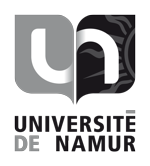 |
|
|
Direction du Personnel Rue de Bruxelles, 61 B-5000 Namur Tél. : +32 (0)81 72 40 40 Fax : +32 (0)81 72 40 48 |
Le Conseil d'administration de
l'Université de Namur annonce la vacance du(des) poste(s) suivant(s) |
PhD student position in Cultural Heritage Science
Grade : researcher
Contract : fixed term contract
Category : scientific personnel
Allocation : External funds
Responsabilities
The research project (entitled PHOENIX) that the PhD candidate is going to pursue will be funded by the Concerted Research Action program of the University of Namur. PHOENIX is a highly collaborative and interdisciplinary project in the field of Cultural Heritage Sciences, which brings together PIs of the Namur Institute of Structured Matter (NISM), the Namur Institute for Complex Systems (naXys) and the Institute Heritages, transmissions & inheritances institute (PaTHs). The project focuses on two types of cultural heritage objects: parchments and coins. PHOENIX aims to develop a methodology based on physicochemical characterizations capable of addressing common objectives for these radically different artefacts. Three objectives will be the determination of date, provenance, and production chain of both artefacts by experimental techniques combined with automated machine learning procedures. The next objective will be to examine to which extent the results obtained by AI challenges existing methods used in historical sciences. Five complementary techniques (µ-Raman, UV/Vis/NIR, ATR-FTIR, IBA, ToF-SIMS) will be used to characterize the artefacts, with a fine tuning of the experimental parameters depending on the type of object. The measurements from each technique will be first analyzed (i.e., pre-screening) to obtain a physicochemical interpretation of the raw data. Then, these pre-screened datasets will be analyzed by various machine learning methods (dimensionality reduction, unsupervised clustering, artificial neural networks). The overall objective will be a critical assessment of the contribution of AI to historical studies, possibly showcasing the emergence of new paradigms in history.
The PhD student will develop his/her research project in the material analysis of parchments and coins. She/he will be trained into the main analytical techniques mentioned above, will carry out the experimental measurements on the artefacts, analyze and interpret the experimental data and interact with two postdoctoral researchers who will be hired on the project, one researcher with expertise in AI who will develop the algorithms, and one researcher in historical sciences who will take in charge the interpretation of the results from an historian’s perspective. The candidate will be supervised by Profs. Cecchet and Colaux and will work in close collaboration with the two postdoctoral researchers hired on PHOENIX and all the project PIs (Profs. Deparis, Flament, Houssiau, Mayer, Ruffini-Ronzani) and their teams.
Profile
We are looking for a highly motivated PhD candidate, who must have a master’s degree in physics, applied sciences, chemistry or assimilated. The candidate is expected to:
• have a background knowledge in spectroscopy and/or materials science;
• be highly motivated by conducting a collaborative and interdisciplinary research project;
• have good communications skills in English (reading, writing and speaking);
• be autonomous;
• be able to present clearly his/her research results.
Candidates are requested to send by e-mail to francesca.cecchet@unamur.be and julien.colaux@unamur.be before June 10th 2024: an updated CV with a motivation letter and two reference letters from professors or previous supervisors. The selection procedure will be based on the analysis of the applications, and on the audition of selected candidates.
Additional information
Starting date: 01/10/2024
Contract : 2-year fixed-term contract, renewable once
Category : PhD student. CANDIDATES MUST NOT HAVE A PHD.
Salary per month: https://www.unamur.be/universite/jobs/baremes
Hiring conditions: If you are not European, you will need a unique permit to work at the University of Namur. The single permit application procedure can take up to 4 months from the moment the application file is complete.
Remarks
Scientific Environnement
The NISM Institute (https://nism.unamur.be/) NISM teams work on various research topics in organic chemistry, physical chemistry, chemistry of materials, surface science, solid state chemistry and physics from theoretical and experimental points of view. It aims at exchanging and sharing skills and ideas in the field of synthesis and functionalization of molecular systems and innovative materials, of 0 to 3 dimensions. It also aims at facilitating the rational design of solids with specific architectures and surface properties, while developing advanced techniques for the study of their physicochemical properties.
The naXys Institute (https://www.naxys.be/) The main objective of naXys is the study of complex systems, by means of the analysis of real-world data, their modelling through mathematics and numerical simulations, and their control and optimization. Our belief is that a proper understanding of systems requires a modelling step, which allows to identify causal relationships between various parameters and to identify the mechanisms by which they operate. This abstraction must be based on empirical validation, but the mining of data alone is neither sufficient nor satisfactory. For this reason, a knowledge of the specific domain and the use of adequate tools in modelling, analysis and simulations are essential.
The PaTHs Institute (https://paths.unamur.be/) The Heritages, Transmissions & Inheritances (PaTHs) Institute is a federation of research centres and groups that have emerged in and around the Arts Faculty of UNamur in recent years. Bringing together the researchers of those entities, it aims to encourage a diachronic approach to social and cultural phenomena in the broadest sense. It also aims to strengthen collaboration between several “human sciences” that are usually perceived as complementary, but whose subjects and research methods are in fact very heterogeneous.
FACILITIES
This PhD project will be pursued by using the technological platform of UNamur LOS, SIAM, and PTCI (https://platforms.unamur.be/)

